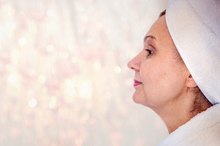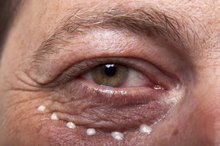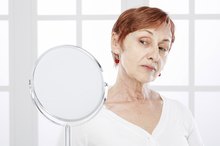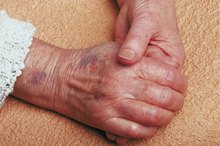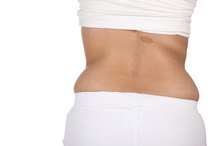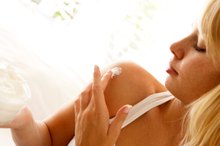What Makes Skin Get Thin & Very Old Looking?
Thin, old-looking skin comes to us all, if we’re lucky. However, when skin thins and ages prematurely, it can be depressing. There’s no need to look old before your time. You can keep skin looking youthful for as long as possible if you treat it right. A healthy diet and avoiding skin-damaging habits can go a long way in staving off old, thin-looking skin.
The Structure of Skin
Skin is the largest organ of the body 4. It primarily consists of two layers: the epidermis, which is the outer, visible layer of skin, and the dermis, which is a thick layer of tissue just beneath the epidermis. The dermis is responsible for supporting the epidermis. To that end, it is composed of a strong mesh of protein fibers, called collagen and elastin. These fibers play an essential role in the appearance of your skin. Collagen is responsible for skin’s firmness, while elastin is responsible for skin’s elasticity.
- Skin is the largest organ of the body 4.
- Collagen is responsible for skin’s firmness, while elastin is responsible for skin’s elasticity.
Cause of Aging Skin
The Best Vitamin for Sagging Facial Skin
Learn More
Skin starts to appear old when the body’s production of collagen slows and the elastin fibers begin to lose their springiness. With the decreased production of collagen, the outer skin has less support and begins to sag. Further, because the elastin fibers have decreased elasticity, the skin does not “snap back” the way it used to, giving it a loose, aged appearance. To top it off, according to the American Academy of Dermatology, as we grow older skin tends to lose its fat, making it thin-looking, and gravity pulls on it, making it droop 1.
- Skin starts to appear old when the body’s production of collagen slows and the elastin fibers begin to lose their springiness.
- Further, because the elastin fibers have decreased elasticity, the skin does not “snap back” the way it used to, giving it a loose, aged appearance.
Cause of Prematurely Aging Skin
AgingSkinNet reports that changes to collagen and elastin begin in the mid-20s, although the subsequent changes in your skin don’t usually become visible until decades later 3. However, some circumstances can hasten the weakening of these fibers, and make you look old before your time. According to MayoClinic.com, smoking and exposure to sun can damage collagen and elastin fibers, and greatly heighten the chances of developing wrinkles and sagging skin prematurely 2. In addition, other environmental factors, such as pollution and exposure to secondhand smoke, can also cause damage to skin fibers.
Treatment
How to Firm Up Skin After Menopause
Learn More
A variety of treatments exist for improving the appearance of old-looking or thin skin. In one popular treatment, called “dermal filler,” a dermatologist injects a filler, usually made of collagen or fat, into the skin 4. The filler plumps the skin and decreases facial lines. Another common treatment is retinoic acid, a cream that can enhance the texture of the skin, and according to the AAD, may boost the production of collagen if regularly applied for several months. A classic face-lift can make skin appear tighter and more youthful as well. However, no treatment can permanently reverse the effects of aging.
- A variety of treatments exist for improving the appearance of old-looking or thin skin.
- Another common treatment is retinoic acid, a cream that can enhance the texture of the skin, and according to the AAD, may boost the production of collagen if regularly applied for several months.
Prevention/Solution
Aging skin is inevitable. Nonetheless, the best way to avoid prematurely aging skin is to change lifestyle habits that affect your skin. Cigarette smokers should quit smoking, and sun-lovers should apply ample amounts of sun screen a good 30 minutes before exposing their skin to the sun. A healthy diet can also help keep skin youthful-looking. MayoClinic.com recommends eating foods low-fat and rich in vitamins C for clear, young-looking skin 2.
- Nonetheless, the best way to avoid prematurely aging skin is to change lifestyle habits that affect your skin.
- MayoClinic.com recommends eating foods low-fat and rich in vitamins C for clear, young-looking skin 2.
Related Articles
References
- American Academy of Dermatology: Mature Skin
- MayoClinic.com: 5 tips for Healthy Skin
- AgingSkinNet: Basic Facts
- Smart Skin Care: What is the Skin Made Of?
- Kanitakis J. Anatomy, histology and immunohistochemistry of normal human skin. Eur J Dermatol. 2002 Jul-Aug;12(4):390-9.
- Habif TP. Clinical Dermatology E-Book. 5th ed. Elsevier Health Sciences; 2009.
- Dutton J, Gayre G, Proia A. Diagnostic Atlas of Common Eyelid Diseases. New York: Taylor & Francis Ltd.; 2007:1. doi:10.3109/9781420016321
- Alberts B, Johnson A, Lewis J, Raff M, Roberts K, Walter P. Molecular Biology of the Cell, 4th ed. New York: Garland Science; 2002.
- Kakasheva-Mazhenkovska L, Milenkova L, Gjokik G, Janevska V. Variations of the histomorphological characteristics of human skin of different body regions in subjects of different age. Prilozi. 2011;32(2):119-28.
- Sandby-Møller J, Poulsen T, Wulf HC. Epidermal thickness at different body sites: relationship to age, gender, pigmentation, blood content, skin type and smoking habits. Acta Derm Venereol. 2003;83(6):410-3. doi:10.1080/00015550310015419
- Rahrovan S, Fanian F, Mehryan P, Humbert P, Firooz A. Male versus female skin: What dermatologists and cosmeticians should know. Int J Womens Dermatol. 2018 Jun 22;4(3):122-130. doi:10.1016/j.ijwd.2018.03.002
Writer Bio
Barbara Diggs is a freelance writer living in France. A former corporate lawyer, she has been writing professionally since 2006. She has been published in numerous print and online magazines, specializing in travel, parenting, history and law. Diggs is a graduate of Wesleyan University and Stanford Law School.

